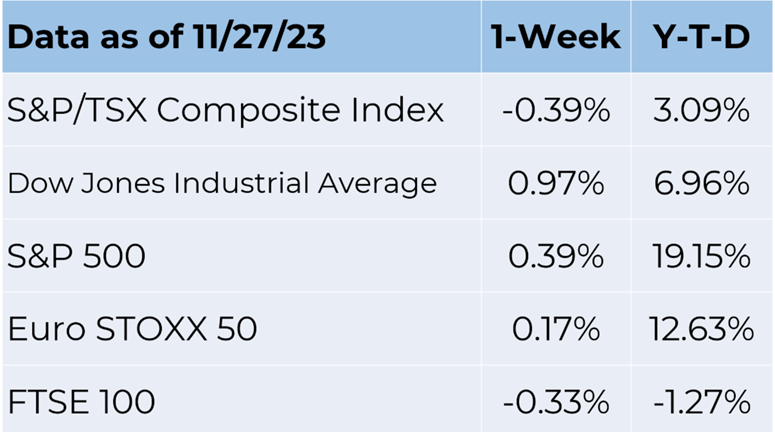Weekly Market Commentary November 30th 2023
The Markets
In November, investors were more optimistic than consumers.
At the start of November, investors were decidedly bearish. During the week of November 1, the AAII Investor Sentiment Survey found that about 50 percent of respondents were pessimistic about the prospects for stocks over the next six months, and about 24 percent were bullish. The current historical averages are 31 percent bearish and 37.5 percent bullish. (The remainder are neutral.)
Many believe the survey is a contrarian indicator, meaning that stocks are likely to rise when investors are bearish and fall when investors are bullish. November offered some data to support the theory as United States stocks trended higher during the month.
As stock markets gained, participants in the AAII survey became more bullish. The Thanksgiving week survey found that more than 45 percent of respondents were feeling bullish, and as we already mentioned, just 24 percent were feeling bearish.1 Quite a reversal from four weeks earlier.
Consumers were considerably less optimistic. While sentiment improved from last year, it dropped almost 4 percent from October to November, according to the University of Michigan Consumer Sentiment Survey. It was the fourth consecutive month of declining sentiment.
“November’s reading reflects a balance of factors, some of which improved while others worsened. More-favorable current assessments and expectations of personal finances were offset by a notable deterioration in expected business conditions…Younger and middle-aged consumers exhibited strong declines in economic attitudes this month, while sentiment of those age 55 and older improved from October,” wrote Surveys of Consumers Director Joanne Hsu.
The survey found consumers expect inflation to average 4.5 percent over the next 12 months, and 3.2 percent over the longer term even though inflation has slowed significantly and was just 3.2 percent over the last 12 months. Despite recent declines, consumers are worried inflation could change course.
The CCI for Canada was 91.6 in October 2023, which was a slight increase from 90.9 in September 2023. The CCI for Canada has been recovering from the sharp decline caused by the COVID-19 pandemic, but it is still below the pre-pandemic level of 120.6 in February 2020.
Stocks moved higher last week as many investors remained confident the Federal Reserve was done raising rates. Some anticipate rate cuts early next year, reported Barron’s. Bond markets weren’t so sure, though, and U.S. Treasury yields moved broadly higher during the week.
The Canadian stock market also moved higher last week, as the S&P/TSX Composite index gained 0.48% from Monday to Friday, closing at 20,111.11 on Friday. The index was supported by the positive performance of some sectors, such as information technology, health care, and industrials. The index also benefited from the optimism about the economic recovery and the easing of COVID-19 restrictions in Canada.

Source: FactSet


DRIP. DRIP. DRIP. As inflation recedes, fees and charges may continue to affect the cost of some goods and services. Last summer, NPR’s Stacey Vanek Smith reported on the phenomenon after having lunch delivered.
According to the latest Consumer Price Index (CPI) report from Statistics Canada, the annual inflation rate in Canada was 6.8% in October 2023, the highest since June 1991. This means that the average price level of a basket of goods and services purchased by Canadian consumers increased by 6.8% compared to October 2022. The main drivers of inflation in October 2023 were gasoline prices (up 49.6%), homeowners' replacement cost (up 17.9%), passenger vehicles (up 11.9%), and food (up 5.4%).
“I decided to splurge and order a burger and fries for delivery. Subtotal for my meal? $14.07. A little pricey, but it’s a good burger and $14 seemed like a totally acceptable price for dinner, especially when it's delivered to my door. Then came the fees: Delivery fee: $5.49; Service fee: $3; Tip: $4; Tax: $1.25. Grand total for my delivery burger: $27.81. My lazy Monday went from costing me $14 to almost $30. The price had doubled. What was going on?
The answer is drip pricing. It happens when the price of a good or service is broken into multiple components that the buyer becomes aware of as the purchase proceeds, according to an article published by Alexander Rasch, Miriam Thöne and Tobias Wenzel in the Journal of Economic Behavior and Organization.
Many industries employ this pricing strategy. For example, travelers may purchase airline tickets by choosing the lowest base price and then find themselves paying additional fees to check bags, select desirable seats or sit in seats adjacent to younger family members.
One luxury automobile company added a new twist to car buying. It asked buyers in the United Kingdom, Germany, New Zealand and South Africa to pay a subscription fee to activate its factory-installed seat warmers. The automaker eventually abandoned the subscription, but it plans to expand pay-on-demand services. In an interview with James Attwood of Autocar, a company board member explained:
“We actually are now focusing with those ‘functions on demand’ on software and service-related products, like driving assistance and parking assistance, which you can add later after purchasing the car, or for certain functions that require data transmission that customers are used to paying for in other areas.”
Weekly Focus – Think About It
"It isn't what we don't know that gives us trouble, it's what we know that ain't so”
—Will Rodgers, comedian
Best regards,
Eric Muir
B.Comm (Hons. Finance), CIM®, FCSI
Senior Portfolio Manager
Derek Lacroix
BBA, CIM®, CFP®
Associate Portfolio Manager

P.S. Please feel free to forward this commentary to family, friends or colleagues. If you would like us to add them to the list, please reply to this email with their email address and we will ask for their permission to be added.
Disclaimer:
Information in this article is from sources believed to be reliable, however, we cannot represent that it is accurate or complete. It is provided as a general source of information and should not be considered personal investment advice or solicitation to buy or sell securities. The views are those of the author, Eric Muir and Derek Lacroix and not necessarily those of Raymond James Ltd. Investors considering any investment should consult with their Investment Advisor to ensure that it is suitable for the investor’s circumstances and risk tolerance before making any investment decision. Raymond James Ltd. is a Member Canadian Investor Protection Fund.


